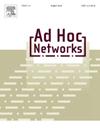NOMA-based intelligent resource allocation and trajectory optimization for multi-UAVs assisted semantic communication networks
IF 4.4
3区 计算机科学
Q1 COMPUTER SCIENCE, INFORMATION SYSTEMS
引用次数: 0
Abstract
The limited spectrum resources have a particular impact on UAV-assisted semantic communication networks, which undoubtedly leads to poorer quality of service for users and inefficient communication. Therefore, a NOMA-based multi-UAVs assisted semantic cellular network framework is proposed in this paper, in which each UAV transmits semantic information to multiple users in the shared spectrum resource with different power using non-orthogonal multiple access transmission protocol, thereby achieving higher spectrum utilization. We optimize the quantity of semantic symbols, UAV trajectories, and power allocation concurrently to increase communication efficiency by maximizing the sum rate of semantic information transmission for all users. However, conventional convex optimization approaches have difficulty solving it due to the bi-directional mobility of UAVs and users. Therefore, an enhanced K-means algorithm is employed to create the relationship between UAVs and users periodically. Additionally, a deep reinforcement learning technique based on shared dueling double deep Q networks (SD3QN) is also presented to maximize the quantity of semantic symbols, 3D trajectories, and power allocation. Experimental results show that the proposed semantic cellular network achieves higher spectral efficiency. Meanwhile, the proposed algorithm can effectively reduce the training time and avoid the overestimation problem in Deep Q Networks (DQN). Furthermore, the suggested optimization strategy outperforms the benchmark schemes in terms of semantic sum rate.
求助全文
约1分钟内获得全文
求助全文
来源期刊

Ad Hoc Networks
工程技术-电信学
CiteScore
10.20
自引率
4.20%
发文量
131
审稿时长
4.8 months
期刊介绍:
The Ad Hoc Networks is an international and archival journal providing a publication vehicle for complete coverage of all topics of interest to those involved in ad hoc and sensor networking areas. The Ad Hoc Networks considers original, high quality and unpublished contributions addressing all aspects of ad hoc and sensor networks. Specific areas of interest include, but are not limited to:
Mobile and Wireless Ad Hoc Networks
Sensor Networks
Wireless Local and Personal Area Networks
Home Networks
Ad Hoc Networks of Autonomous Intelligent Systems
Novel Architectures for Ad Hoc and Sensor Networks
Self-organizing Network Architectures and Protocols
Transport Layer Protocols
Routing protocols (unicast, multicast, geocast, etc.)
Media Access Control Techniques
Error Control Schemes
Power-Aware, Low-Power and Energy-Efficient Designs
Synchronization and Scheduling Issues
Mobility Management
Mobility-Tolerant Communication Protocols
Location Tracking and Location-based Services
Resource and Information Management
Security and Fault-Tolerance Issues
Hardware and Software Platforms, Systems, and Testbeds
Experimental and Prototype Results
Quality-of-Service Issues
Cross-Layer Interactions
Scalability Issues
Performance Analysis and Simulation of Protocols.
 求助内容:
求助内容: 应助结果提醒方式:
应助结果提醒方式:


